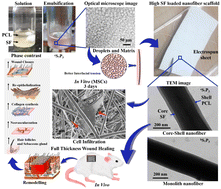High fibroin-loaded silk-PCL electrospun fiber with core–shell morphology promotes epithelialization with accelerated wound healing†
Abstract
Silk fibroin (SF) is a widely explored biopolymer for wound-healing applications due to the presence of amino acids in the biodegradable polymer chain with superior mechanical properties. Herein, a high SF-loaded fibrous matrix along with poly(ε-caprolactone) (PCL) was fabricated using electrospinning of emulsion and blend compositions to modulate nanostructure morphology. A comparative study of the physicomechanical properties of electrospun fibers with emulsion (eS7P3) and homogenous blend (bS7P3) was performed as well. In both compositions, SF loading of up to 70% was successfully achieved in the spun fibers while emulsion yielded core–shell morphology, and the blend resulted in monolith fiber architecture as evidenced by TEM microscopy. Further characterization revealed superior mechanical properties in S7P3 fiber with core–shell morphology, as compared to those in the monolith in terms of a higher degree of crystallinity with Young's modulus of 60 MPa under tensile test and nanoindentation modulus of 1.59 ± 0.8 GPa. Further, eS7P3 nanostructure morphology containing silk in the core with a thin outer layer of PCL facilitated relatively faster biodegradation in the lysozyme medium, as compared to that in the monolith. Owing to the presence of a hydrophobic shell, protein adsorption on the fibrous mat presented slow but steady kinetics up to 24 h. When the scaffold was seeded with human placenta-derived mesenchymal stem cells (hPMSCs), in vitro study confirmed that the eS7P3 structure had marginally higher cell proliferation with superior cell infiltration than the monolith. Further, in vivo study involving a rodent model showed the potential of the eS7P3 fiber substrate with a core–shell structure for accelerating full-thickness wound healing by inducing hair follicle and wound closure with less scar formation after 15 days.

- This article is part of the themed collection: 2022 Journal of Materials Chemistry B Most Popular Articles


 Please wait while we load your content...
Please wait while we load your content...